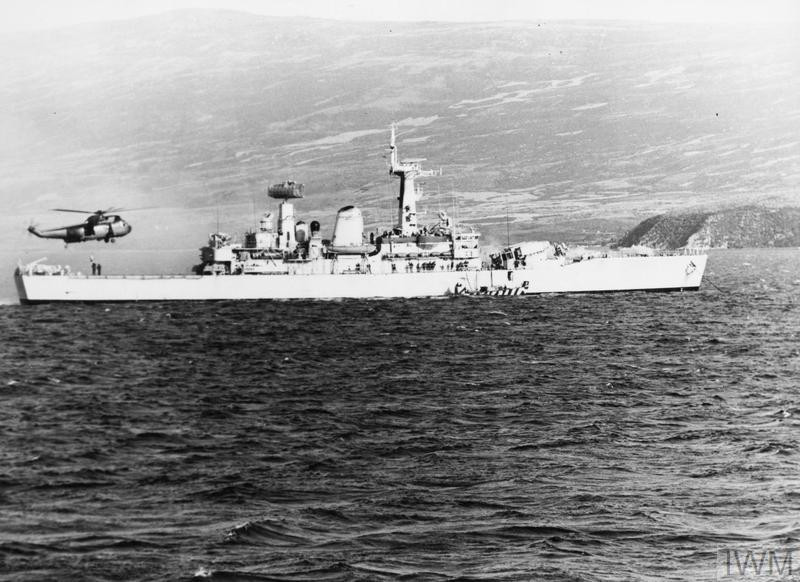Wednesday 26 May 1982 saw slow British progress on land and a great deal of relief amongst the maritime community as unexploded Argentine bombs were safely removed from three ships of the task force.
Brig Julian Thompson RM, Commander of 3 Cdo Brigade, met with his staff on the morning of 26 May and revised their plans in the light of the loss of vital Chinook helicopters in Atlantic Conveyor, which had been all but destroyed by Argentine Exocet missiles the day before.
The big merchant ship, which also carried bombs, a vast array of helicopter spares and a full Harrier airstrip in kit form, was still burning out at sea on the morning of 26 May, and any faint hopes of salvaging material from her were quickly dismissed as another internal explosion blew most of her bows off.
Under the new plans, Goose Green was to be taken and held, and those troops who could not be lifted into battle by helicopter would just have to make the journey to Stanley on foot. The Royal Marines’ slang term ‘yomping’ – a long-distance march overland with full battle kit – was soon to become a familiar term to the general British public.
Troops of 2 Para started their push from Sussex Mountains to Goose Green in the evening of 26 May, with Royal Marines of L Coy 42 Cdo being flown by helicopter from San Carlos to take the place of the paratroopers.
Goose Green and Darwin are small settlements at either end of an isthmus or land bridge that separates the north-east part of East Falkland from the peninsula of Lafonia, the south-western part of the island.
In May 1982 these two settlements were Argentine strongholds, which posed something of a threat to the British landing site at San Carlos Water on Falkland Sound; a successful assault on the Argentines would also boost British morale at a time when Operation Corporate was showing indications of a loss of momentum and the task group had taken a hammering in the past few days.
Before this push, the ship’s companies of three British vessels were nervously awaiting the outcome of bomb-disposal operations, the result of air attacks in the preceding days.
The men of Leander-class frigate HMS Argonaut had the longest to worry, having taken two bombs on 21 May during a raid by Skyhawk bombers, neither exploding but one of which had lodged in her Seacat magazine.
Members of Fleet Clearance Diving Team 1 were flown on board the damaged frigate by helicopter to begin the process of making the bombs safe or removing them, starting with the dangerous task of removing missiles from the magazine where one of the bombs had come to rest.
Argonaut had been patched up and seawater pumped out, but there was no clear route by which the bomb could be removed. That route had to be cut and lifting gear fitted, allowing the bomb to subsequently be removed safely.
RFA Sir Lancelot and RFA Sir Galahad both shipped their 1,000lb bombs on 24 May; both unexploded devices were removed successfully, Sir Galahad’s on 26 May and Sir Lancelot’s three days later.
In the case of Sir Galahad, Fleet Clearance Diving Team 3 managed to move the bomb out onto the deck overnight and then lowered it into an inflatable Gemini dinghy filled with boxes of corn flakes and two Board of Trade lifejackets by way of padding.
The dinghy was then towed out clear of the ships and sunk along with the bomb before the team moved on to attend to Sir Lancelot.
The crew of Sir Lancelot, who had left their ship on 24 May to spend a night ashore, then moved on to RFA Stromness on 25 May, were transferred to RFA Sir Tristram at sea on 26 May, and did not go back to their own damaged ship until 3 June, when they continued making repairs.
Diplomatic efforts to end the Falklands Conflict continued at the United Nations, with the Security Council unanimously adopting Resolution 505 on 26 May, noting that the situation in the South Atlantic had deteriorated and calling on the UK and Argentina to work with UN Secretary-General Javier Perez de Cuellar to achieve a ceasefire, possibly monitored by UN observers.
Welcome reinforcements rendezvoused with the British task group on 26 May in the form of the Bristol Group – apart from the unique Type 82 destroyer, the group consisted of Type 42 destroyer HMS Cardiff, Type 21 frigates HMS Active and HMS Avenger, and Leander-class frigates HMS Minerva, HMS Penelope and HMS Andromeda – although one of the older ships, Andromeda was at least fitted with Seawolf.
On 26 May, the five small ships of the 11th MCM Squadron arrived at South Georgia, just a couple of days before various ‘high-value’ ships such as Queen Elizabeth 2, packed with the men of 5 Brigade, vital stores and ammunition began arriving.
There was a good deal of rearrangement of stores and cross-decking of men and equipment to be achieved in a short period, allowing them to be transported on to the Falklands and the Task Group at sea, and the trawler-minesweepers worked long days as ferries in atrocious weather, with wind speeds on occasions gusting over 100 knots, before heading on towards the Falklands.
Today’s image from the Imperial War Museum collection (© IWM FKD 147) shows a Royal Navy Sea King hovering over the stern of HMS Argonaut to deliver members of Fleet Clearance Diving Team 1 to the frigate, where they attended to an unexploded 1,000lb bomb.
* These posts can only give a brief sense of what was a complex and fast-moving situation 40 years ago, and cannot cover the involvement of every ship, squadron and unit in detail – for a much more comprehensive account see the Falklands section of naval-history.net at https://www.naval-history.net/NAVAL1982FALKLANDS.htm
